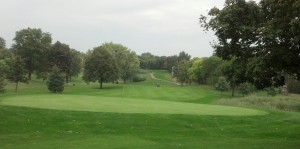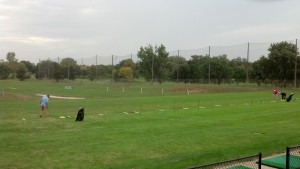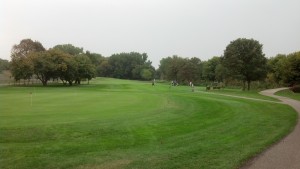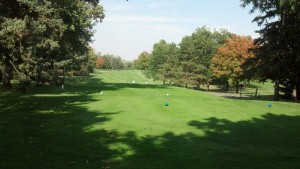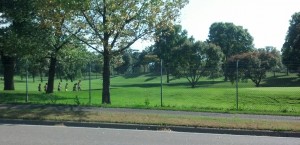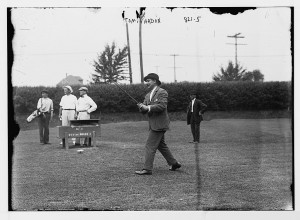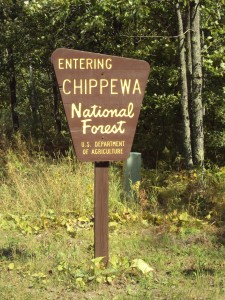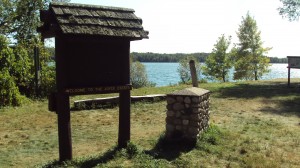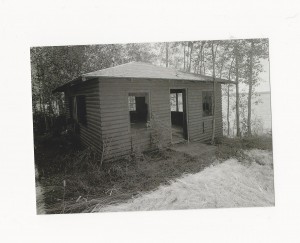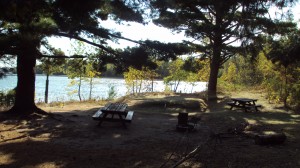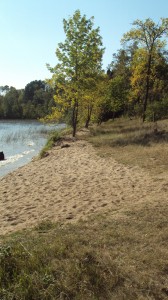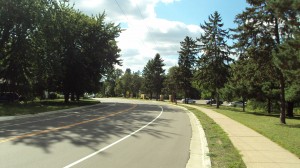Friday marked Day 3 of the Great, Or Maybe Fair to Middling, Flyer Distribution Tour. Six north-metro courses visited. Would have been seven, except for MNDot’s carefully devised scheme to block off 147 streets and highways in a five-mile-square area and prevent any motorized vehicles from visiting certain neighborhoods in New Brighton, Shoreview and Arden Hills.
I’ll offer few real revelations about the places I visited, just a few ruminations:
Island Lake Golf and Training Center, Shoreview: Great location, within a purely struck 8-iron of the hardpan known as I-694. I’ve hit balls here but never played the course. Fine driving range. This place is best known in my family for the miniature golf course, which my son Nick really enjoys, but where he almost never actually finishes a hole.
Hey, Nick, may I remind you of this little golf technicality, found in the appropriately capitalized Rules of Golf:
3-2. Failure to Hole Out
If a competitor fails to hole out at any hole and does not correct his mistake before he makes a stroke on the next teeing ground or, in the case of the last hole of the round, before he leaves the putting green, he is disqualified.
Columbia Golf Club, Minneapolis: “Columbia Golf Club started as a simple 6-hole, sand green golf course in 1919 and was expanded to 18 holes in 1923,” the Minneapolis Parks website says. That history nugget, the large hardwood trees and the clubhouse with the yellow-rock facing always make me feel like I’m going back in time whenever I visit here — and that’s not a bad thing. Columbia has something of a “Keller” feel around the clubhouse, referencing the great old public course in Maplewood, though it’s tough to place any other Minneapolis or St. Paul muni in the same class as Keller.
Columbia was laid out by William D. Clark, a well-known Twin Cities course architect of the 1920s and ’30s. Little-known fact about Clark: He also designed what was originally a six-hole layout in Chisago City and is now a lost course.
Columbia’s other lost-course connection: It is the longtime home of Mike Rak, a former state senior public links champion who caddied and then played the defunct Hilltop Public Golf Links course two miles up the road in Columbia Heights. Rak is a wonderful gentleman and storyteller who stoked my interest in writing “Fore! Gone.” by spending three hours last July touring the old Hilltop grounds with me and then telling me more about the place at his north Minneapolis home. Rak was part of a contingent of remarkably skilled north Minneapolis and Columbia Heights players who matriculated from Hilltop in the 1930s and ’40s and went on to notable amateur careers at the likes of Columbia and Gross.
Columbia Learning Center and Driving Range: Adjacent to Columbia Golf Club, this is one of the better practice venues in the Twin Cities. It features target greens, a putting greens and pitching areas. (Speaking of pitching, maybe the Minnesota Twins starting rotation could make an offseason road trip here and work on their form.)
I counted 34 bays to hit from, via my Evelyn Wood-counting style. There might be more. It’s a First Tee facility, helping kids to learn the game. And I like the sign at the door. Paraphrasing: “Home to the Augsburg College golf team. Go Auggies!”
Centerbrook Golf Course, Brooklyn Center: Darn it. My photographic timing was a little off on this one. (Hey, no wisecracks about my photos. They were taken with my Android as I was all but running from one course to the next. And I’m a professional photographer like Amanda Bynes is a professional race car driver.) I snapped this about 10 seconds after a woman top-shank-sclaffed a shot 30 yards to the right off the first tee. I didn’t watch after that, but I doubt she subsequently spun a gap wedge to 18 inches and tapped in for par.
Courses like Centerbrook sometimes have to endure catty comments about the simplicity of their layouts, but one should not question for one second their importance to golf. It’s where beginners learn the game, where novices learn to love the game, where calendars don’t have to be used to measure playing time, and where anyone can play without feeling intimidated. I have the utmost respect for places like Centerbrook. It’s a crying shame so many par-3 and executive courses like this have turned into lost courses in the past 15 years.
Gross National Golf Club, Minneapolis (it’s a Minneapolis address, but it looks to me like the course technically is within the confines of the St. Anthony Village borders): Another William D. Clark design, this course opened in 1925. It’s generally considered the best of the Minneapolis city courses, and it hosted the 1964 U.S. Public Links Championship.
Gross wasn’t originally Gross. (Hey, again — no wisecracks.) Like many of the Minneapolis courses, it was renamed. Gross originally was named Armour. The meatpacking company owned the land upon which Armour/Gross was built. The course was renamed after Francis A. Gross, who was known as “Mr. Park Board” and was Minneapolis park commissioner for 32 years. It’s a pretty fair value, at $28 weekdays and $32 weekends.
Les Bolstad Golf Course, Falcon Heights: 16 holes north of Larpenteur Avenue and two holes south of it. Best known as the University of Minnesota golf course, and less well-known as the first golf course on which I played 36 holes in one day — and in brand-new golf shoes, to boot. (The modestly talented Winona State team I played for came up for an invitational meet in the late 1970s, and I forgot my shoes. Had to buy new ones at the course. The shoes and I both made it through all 36 holes. I wonder where those shoes are now. Dang, they were comfy.
( I can’t tell my other WSU/Bolstad story, or I might have my college golf letters retroactively rescinded. I can say it has to do with missing a tee time.)
Bolstad isn’t long enough to support modern-day college meets, but it’s still a fine everyday track, and it has an excellent practice facility designed by ex-Gopher Tom Lehman, a player of some repute. Thankfully, the U regents decided recently not to close down the Bolstad course and make it fodder for “Fore! Gone. Version 2.0.” (Don’t worry. There probably won’t be one of those.)
The hole pictured is No. 14, a short par 4, 280 yards off the white tees. Yes, those are runners on the course grounds. Bolstad is host to the annual Griak Invitational, one of the Midwest’s top college and high school cross country meets. The meets are today, and those runners were training yesterday. I photographed No. 14 so I could boast about having driven the green the last time I played Bolstad.
Yes, I three-putted for par.
Lost-course connections: Bolstad was designed by Tom Vardon, the prolific designer of the 1920s and ’30s who laid out five lost courses that are featured in my book. Also, the course was named for Les Bolstad, the former U of M golf coach who once served as head professional at Westwood Hills, a lost course in St. Louis Park. And before there was the University golf course, the school’s first intercollegiate meet was played at The Minnetonka Club in Deephaven, also known as the Burton Private Course, another lost course I wrote about.
Finally, the latest Kickstarter update: 13 days to go, $2,590 raised, $2,410 to reach goal. Have I mentioned I need pledges? Have I mentioned I can’t get the book into print unless I meet the goal? I have? Four hundred and thirty-one times?
Fine. Now it’s 432.

